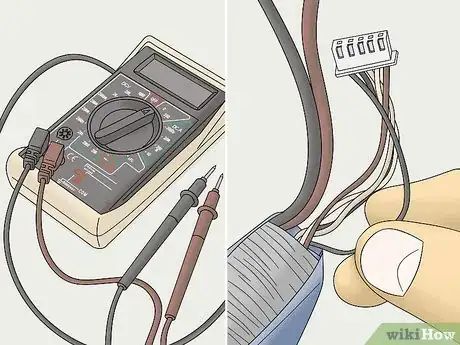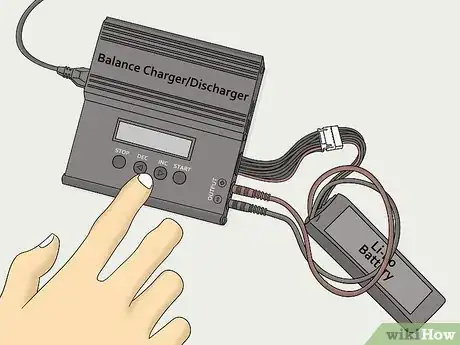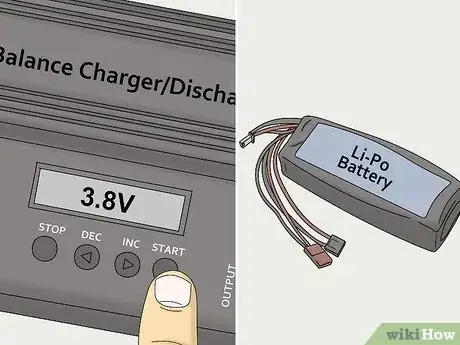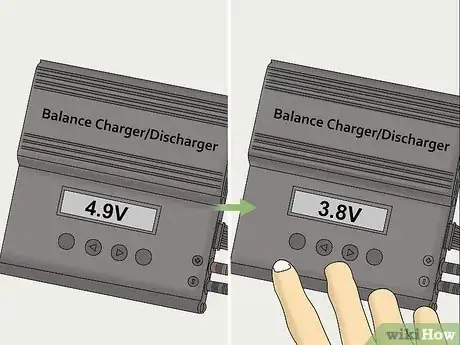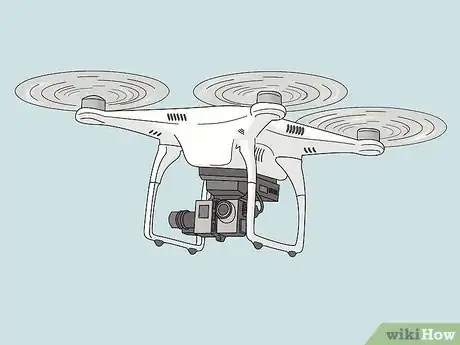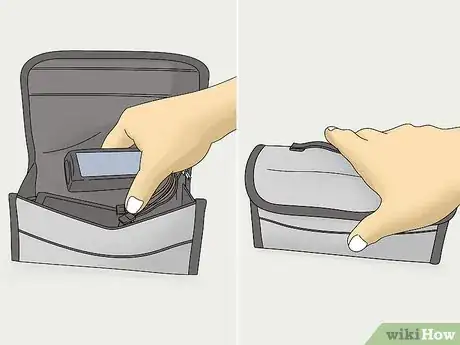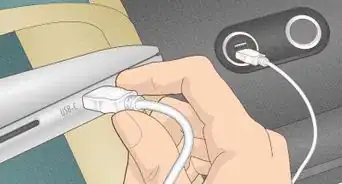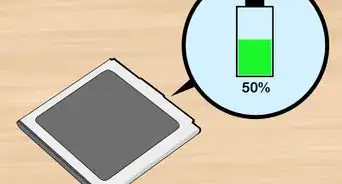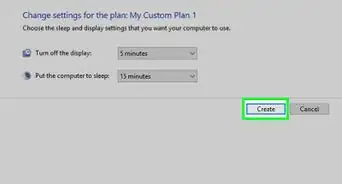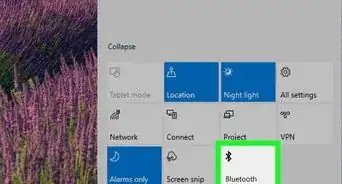This article was co-authored by wikiHow Staff. Our trained team of editors and researchers validate articles for accuracy and comprehensiveness. wikiHow's Content Management Team carefully monitors the work from our editorial staff to ensure that each article is backed by trusted research and meets our high quality standards.
This article has been viewed 29,812 times.
Learn more...
A LiPo (Lithium Polymer) batteries are primarily used in drones and other radio-controlled devices. They can be temperamental power sources, and can even catch fire if they aren’t stored properly. This means you should take extra care when storing your LiPo batteries. If you won’t be using your battery for more than 4 days, bring it to a default storage charge of 3.8 volts per cell.[1] Then wrap the battery in a fire-retardant bag and store it in a fireproof container for safety. When you’re ready to use the battery again, just charge it back up.
Steps
Bringing the Battery to its Storage Charge
-
1Check the battery voltage to see if you need to charge or discharge it. The resting charge for a LiPo battery is 3.8 volts per cell. Most LiPo chargers come with a volt reader. Insert the balance plug into the port on the charging unit and wait for a reading.[2]
- The balance plug is a white plug connected to several colorful wires coming out of the battery.
- You can also use a plain volt meter if your charger doesn’t have a volt reader. Take the positive wire of the volt meter and connect it to one end of the balance plug, then connect the negative wire to the opposite side. Hold both wires on the plug for a few seconds until the volt meter produces a reading.
-
2Set your battery charging unit to its storage setting if it has one. Some LiPo chargers have a default storage setting. This automatically charges or discharges your battery until it reaches 3.8 volts, making storage prep easy. Set your charger to the storage setting and plug the battery in until it’s finished.[3]
- LiPo batteries charge and discharge slowly. The process should take about an hour.
- Different chargers may have different processes for programming the default setting. Consult your owner’s manual if there isn’t a clear button or switch.
Advertisement -
3Charge your battery if it reads below 3.8 volts per cell. If your battery charger doesn’t have a storage setting, charge it up manually. Set the charger to 3.8 so it automatically stops when the battery hits its storage charge. Then plug the battery in and wait for it to reach its storage charge.[4]
- Leave the battery on a non-flammable surface like stone, metal, or tile while it charges.
- When a LiPo battery is under-charged, gasses can build up inside the cells and make the battery look puffy. This damages the cells and reduces the lifespan of your battery.
-
4Discharge your battery if it reads above 3.8 volts per cell. Many LiPo chargers also have a discharge setting to bring the battery down to its storage charge. If your battery read above 3.8 volts, set the discharge setting to 3.8. Then plug your battery into the charger and wait for it to reach its storage charge.[5]
- Storing a battery while it's over-charged also damages the cells. Pressure can build inside the battery and rupture the cell casings. This could leak gas and cause a fire.
-
5Use the battery until it stops if your charger doesn’t have a discharge setting. In the event your charger doesn’t have a discharge setting and your battery measures over 3.8 volts, your next option is using the battery until it runs below the storage charge and then charging it back up. Connect the battery to your drone or whichever device you use it in, then use the battery until the device stops working. At that point, it’s below the storage charge. Then connect it to the charger and charge it up to 3.8 volts.[6]
- Most LiPo batteries stop working when they reach 3.2 volts. Use this as your baseline when the device stops.
-
6Stay near the battery while it’s plugged in. Whichever method you use to bring your battery to its storage charge, don’t leave the battery unattended while it’s connected to the charger. Damaged LiPo batteries can catch fire while they charge. Keep an eye out for any smoke coming out of the battery. Disconnect it immediately if this happens.[7]
- You don’t have to watch the battery the whole time. Just stay in the same room so you can react quickly if the battery catches fire.
- If the battery does catch fire, pour sand on it to extinguish the flames.
Storing the Battery
-
1Wrap the battery in a LiPo storage bag. Specialized LiPo storage bags are static-proof and fire-retardant to protect the battery and your home while it’s in storage. Place the battery in the bag and seal it.[8]
- If your battery didn’t come with a storage bag, look in a hobby shop or on the internet for one.
- Note that if the battery catches fire, it will eventually burn through the bag. The bag just slows the flames down so you have time to react. This is why you still need more storage precautions in addition to the bag.
-
2Store the wrapped battery in a fireproof container. This protects your home if the battery catches fire while it’s in storage. Ideally, use a metal or stone container that seals. Find a container that isn’t lined with a flammable material like felt or fabric.[9]
- Some container ideas include ammunition cases, fireproof safes, and flower pots.
- Don’t store anything on top of the container.
-
3Lay a sandbag on top of the battery for extra safety. This is an extra, optional safety precaution that some hobbyists recommend. Then if the battery does catch fire, the bag will rupture and the sand will smother the flame.[10]
- Make sure both the sand and the battery are wrapped well so no sand gets into the battery.
- Using sand is important because a LiPo fire is a chemical fire. Spraying water on it could spread the chemicals around and make the fire worse. Sand, on the other hand, covers the flames and extinguishes them without spreading the chemicals.
-
4Place the container in a dry area at room temperature. With the battery safely sealed, store it away until the next time you use it. Temperature swings can damage LiPo batteries, so keep it in a temperate room. Make sure the area stays around room temperature (70 °F (21 °C)) to prolong the battery's lifespan.[11]
- Monitor the weather and move the battery if it's in an area where the temperature will change dramatically. For instance, if your garage tends to get hot and you know it will be 100 °F (38 °C) today, move the battery into the air conditioning until the temperature drops.
- Don't let your battery get too cold either, because condensation can form when it warms back up. Don't leave it in the refrigerator, for example.
-
5Keep the battery away from flammable material. In case the battery catches fire while in storage, make sure it isn't near anything that can burn. Rather than leaving the container on a wooden desk surrounded by paper, place it on a metal shelf or tile floor. Move away any loose paper, fabric, piles of wood, or anything else than can burn.[12]
- Also make sure nothing flammable is above the container. Don't put the container on a tile floor but underneath a wooden shelf. Leave a few feet above the container free.
- Keep a fire extinguisher nearby so you can reach it easily in the event of a fire.
- Make sure the container is away from children or pets who may open it.
Warnings
- Dispose of damaged batteries right away. Damaged LiPo batteries are more likely to start a fire.⧼thumbs_response⧽
- Only use sand or a fire extinguisher if a LiPo battery catches fire. Do not spray it with water. Water will spread chemicals around and could make the fire worse.⧼thumbs_response⧽
- If you see any smoke or puffing from the battery while it charges, unplug it immediately and move it to an area away from anything flammable.⧼thumbs_response⧽
Things You'll Need
- LiPo battery charger
- Voltage reader
- Sand bag
- LiPo storage bag
- Fireproof container
- Fire extinguisher
References
- ↑ https://www.cnet.com/news/how-to-maintenance-store-your-drone-batteries/
- ↑ https://youtu.be/nSB3ES0ONb4?t=171
- ↑ https://amaflightschool.org/getstarted/lipo-battery-basics
- ↑ https://youtu.be/b7FFHKsuJHs?t=392
- ↑ https://www.cnet.com/news/how-to-maintenance-store-your-drone-batteries/
- ↑ https://youtu.be/b7FFHKsuJHs?t=392
- ↑ https://rogershobbycenter.com/lipoguide
- ↑ https://youtu.be/b7FFHKsuJHs?t=451
- ↑ https://rogershobbycenter.com/lipoguide
